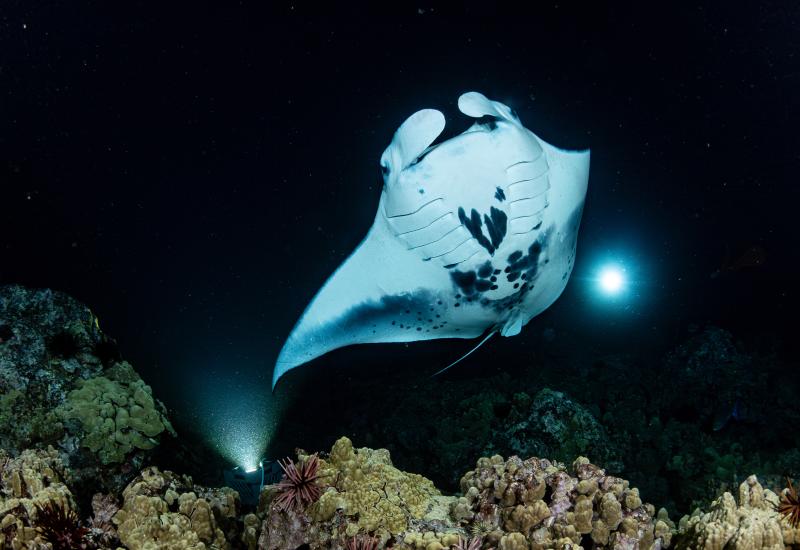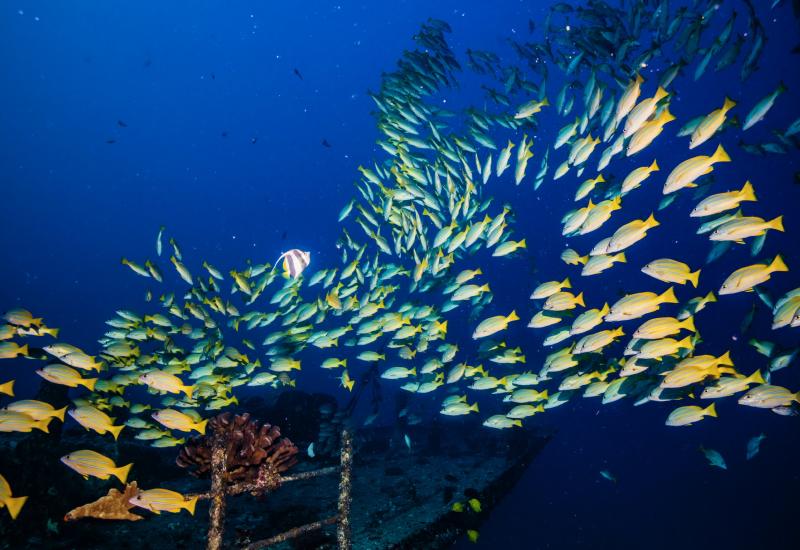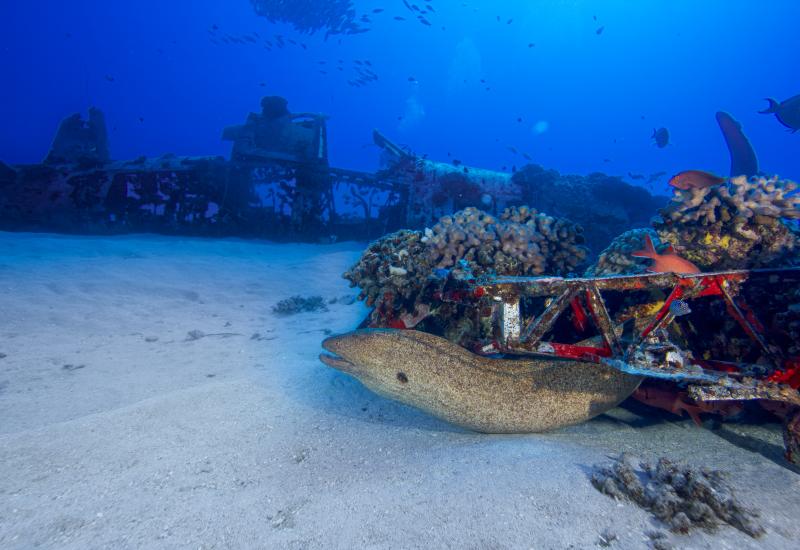Shark Finning on the Frontier
In late 2006, I was invited with photographer Justin Ebert to what may one of the last truly wild places on the planet: Raja Ampat, Indonesia. Located off off the western tip of Papua New Guinea, Raja Ampat covers an area of roughly 7,000 square kilometers and is loaded with forested limestone islands, mangrove ringed lagoons, bays and reefs. It is the reefs in particular that make this place so special. Raja Ampat is believed to have the richest marine biodiversity of any place on the planet.
After seven flights and a long boat trip, 11,000 air miles and 70 hours of travel, we finally arrived at our camp on Batbitim Island in the Misool region of southern Raja Ampat. Our host was Andy Miners, a veteran live-aboard divemaster who was so taken by the beauty and pristine condition of Raja Ampat's reefs, that he made it his personal mission to preserve them. He negotiated a long-term lease on Batbitim Island and is in the process of building Misool Eco Resort. As part of his project, Andy managed to secure an area of 200 square kilometers surrounding Batbitim Island as a no-take zone, the first marine protected area in Raja Ampat. Perhaps even more exciting is the fact that he rallied support for the protected area from the surrounding villages.
Our assignment for the week was to capture on video and in photographs as much of the reefs and marine life in the marine protected area as possible. The video from the trip would be used to promote the resort and help secure investment in the conservation center.
From the first dive on, I was awestruck by the diversity of fish life and intensity of the reef colors. The amount of marine life was staggering, rivaling that of the Galapagos Islands. The water was deep blue with visibility beyond 100 feet. It wasn't until later in the week that something dawned on me. We had not seen sharks on any of our dives. The only exception was a small shark on the house reef belonging to the newly discovered species of epaulette shark (the walking shark). We hadn't even managed a single glimpse of a shark passing in the blue. For such a rich and healthy marine environment, this struck me as incredibly odd. There should have been reef sharks on every dive.
On our last full day of diving, we came face to face with a predator that explained the total absence of the sharks. We had just finished a dive on a site named Gorgonian Passage on the eastern border of the preserve, and began motoring back to the Batbitim. Only minutes into our journey back, we noticed a suspicious boat anchored in the mouth of a lagoon. Concerned that he might be fishing we altered course to intercept the boat and tell him of the reserve's no-take status. As we drew closer, we made a gruesome discovery. On the deck of his fishing boat were dozens of shark fins, recently severed and now drying in the sun. Flies were buzzing around the fins on the blood-soaked decking. By the looks of the fins, these must have been from small reef sharks.
An odd reflection from the shallow reef below the fishing boat caught our attention. The outline was unmistakable. This was the body of a shark. It took no time to notice that the shark had no fins or tail. Through the clear water, more shark carcasses came into focus, strewn across the reef around the fishing boat. As we pulled alongside the boat, the strong smell of drying shark flesh, baked by the equatorial sun, enveloped us. The fishermen glanced up from his meager lunch and gave us a questioning look.
It's hard to describe my thoughts at that moment. Blood-stained fins, mutilated sharks, the stench, and an unconcerned fisherman, all in this pristine lagoon. Everything about the situation was wrong. The feeling of powerlessness was overwhelming. We were too late. He had taken the last sharks, our sharks, my sharks. If we had arrived earlier, before he killed them, we could have freed some of the sharks. But we hadn't. My hands were shaking from anger and desperation. Here was the reason I had not seen any sharks this week.
Andy immediately took control of the situation. Boarding the boat, he demanded to see the man's fishing permit. Having spent many years in Indonesia interacting with the local villagers, Andy is remarkably fluent in the local language. His decisive action snapped me out of my trance. Suddenly it was crystal clear what I had to do. I popped open the door on my video housing, lifted my camcorder and hit record. I filmed all I could: the fins, the boat, the fishermen, the sharks rolling below on the reef, the surrounding lagoon, more shots of fins, different angles. I just kept the camera rolling.
After a short while, a small dugout canoe approached from deeper within the lagoon. Balled up in the bow of the boat was a monofilament gill net. Further forward in the bow were various colorful reef fish and a titan triggerfish, all gasping as they suffocated in the hot sun. The fisherman from the canoe boarded the fishing boat and informed Andy that he was in charge of this boat. While this transpired, I reloaded my camcorder into the housing and threw on my snorkel gear. Topside was only part of the story. What lay below on the reef was perhaps even more important.
I took a deep breath and descended 10 feet to the reef. My stomach turned as I focused on the first of the finned sharks. Though very much dead, the ghastly wounds were so fresh that it almost seemed alive. I imagined the exhausted shark violently pulled on the boat deck. While its fins and tail are sliced off, it wriggles in vain to free itself. Bleeding, the shark is dumped in the water, but with no fins, it helplessly sinks to the bottom. The lack of flow over its gills gradually starves it of life-giving oxygen. Finless, it is trapped on the bottom and suffocates. I counted almost a dozen black tip reef shark carcasses, all juveniles.
Climbing back in the boat, I was struck by the look on everyone's faces. They all looked how I felt--stunned. As we motored out of the lagoon, Andy explained that the fishermen had produced a hand-written permit that was apparently signed by the head of the local villages. Andy would address this when we got back to the island. The permit cost the equivalent of US $30 and gave the fisherman the right to fin sharks for 30 days. Doing some quick math, I estimated he'd harvested 300 hundred sharks for 30 bucks. That's 10 cents a shark. Is that all a shark's life is worth? A bowl of shark fin soup sells for up to US $150 in Asia. Each of these sharks would produce more than a few bowls worth. Doing a little more math, I calculated US $1,000 in shark fin soup per shark. So, the local community was receiving 10 cents or 1/10,000th of the profit from this business. Shark fin traders were clearly exploiting the ignorance of these villagers and devastating their natural resources in the process. How criminal. How sad.
We somberly motored back toward Batbitim Island. There wasn't much to say and we all had plenty to occupy our minds. Eventually we passed the opening of another large mangrove sanctuary. On our way out earlier that morning, we has passed this same entrance and decided we would explore it on our way back. Everything was different now and our enthusiasm had waned. Reluctantly, we kept to plan and slowly floated in to the lagoon. It was breathtaking. Turquoise waters met dense mangroves, rising to deep green rainforest, and back-dropped by radiant blue skies. A magnificent osprey soared from the tree tops while a school of large parrotfish darted below. We soaked it all in, cleansing our souls of the ugliness of the past hour. There was still so much beauty here, still so much worth preserving. A sudden movement below the surface caught our attention. A black tip shark glided past our boat in the shallows, moving with deliberation, making its way to the mouth of the sanctuary. All eyes were glued to the shark. Silently we followed its movements until its silhouette melted in reflections of the mangroves on the water. We all smiled. A living shark. This one had made it. There must be more where it came from. We had some conservation work left to do here and with renewed conviction, we were ready for it. --Shawn Heinrichs
In late 2006, I was invited with photographer Justin Ebert to what may one of the last truly wild places on the planet: Raja Ampat, Indonesia. Located off off the western tip of Papua New Guinea, Raja Ampat covers an area of roughly 7,000 square kilometers and is loaded with forested limestone islands, mangrove ringed lagoons, bays and reefs. It is the reefs in particular that make this place so special. Raja Ampat is believed to have the richest marine biodiversity of any place on the planet.
After seven flights and a long boat trip, 11,000 air miles and 70 hours of travel, we finally arrived at our camp on Batbitim Island in the Misool region of southern Raja Ampat. Our host was Andy Miners, a veteran live-aboard divemaster who was so taken by the beauty and pristine condition of Raja Ampat's reefs, that he made it his personal mission to preserve them. He negotiated a long-term lease on Batbitim Island and is in the process of building Misool Eco Resort. As part of his project, Andy managed to secure an area of 200 square kilometers surrounding Batbitim Island as a no-take zone, the first marine protected area in Raja Ampat. Perhaps even more exciting is the fact that he rallied support for the protected area from the surrounding villages.
Our assignment for the week was to capture on video and in photographs as much of the reefs and marine life in the marine protected area as possible. The video from the trip would be used to promote the resort and help secure investment in the conservation center.
From the first dive on, I was awestruck by the diversity of fish life and intensity of the reef colors. The amount of marine life was staggering, rivaling that of the Galapagos Islands. The water was deep blue with visibility beyond 100 feet. It wasn't until later in the week that something dawned on me. We had not seen sharks on any of our dives. The only exception was a small shark on the house reef belonging to the newly discovered species of epaulette shark (the walking shark). We hadn't even managed a single glimpse of a shark passing in the blue. For such a rich and healthy marine environment, this struck me as incredibly odd. There should have been reef sharks on every dive.
On our last full day of diving, we came face to face with a predator that explained the total absence of the sharks. We had just finished a dive on a site named Gorgonian Passage on the eastern border of the preserve, and began motoring back to the Batbitim. Only minutes into our journey back, we noticed a suspicious boat anchored in the mouth of a lagoon. Concerned that he might be fishing we altered course to intercept the boat and tell him of the reserve's no-take status. As we drew closer, we made a gruesome discovery. On the deck of his fishing boat were dozens of shark fins, recently severed and now drying in the sun. Flies were buzzing around the fins on the blood-soaked decking. By the looks of the fins, these must have been from small reef sharks.
An odd reflection from the shallow reef below the fishing boat caught our attention. The outline was unmistakable. This was the body of a shark. It took no time to notice that the shark had no fins or tail. Through the clear water, more shark carcasses came into focus, strewn across the reef around the fishing boat. As we pulled alongside the boat, the strong smell of drying shark flesh, baked by the equatorial sun, enveloped us. The fishermen glanced up from his meager lunch and gave us a questioning look.
It's hard to describe my thoughts at that moment. Blood-stained fins, mutilated sharks, the stench, and an unconcerned fisherman, all in this pristine lagoon. Everything about the situation was wrong. The feeling of powerlessness was overwhelming. We were too late. He had taken the last sharks, our sharks, my sharks. If we had arrived earlier, before he killed them, we could have freed some of the sharks. But we hadn't. My hands were shaking from anger and desperation. Here was the reason I had not seen any sharks this week.
Andy immediately took control of the situation. Boarding the boat, he demanded to see the man's fishing permit. Having spent many years in Indonesia interacting with the local villagers, Andy is remarkably fluent in the local language. His decisive action snapped me out of my trance. Suddenly it was crystal clear what I had to do. I popped open the door on my video housing, lifted my camcorder and hit record. I filmed all I could: the fins, the boat, the fishermen, the sharks rolling below on the reef, the surrounding lagoon, more shots of fins, different angles. I just kept the camera rolling.
After a short while, a small dugout canoe approached from deeper within the lagoon. Balled up in the bow of the boat was a monofilament gill net. Further forward in the bow were various colorful reef fish and a titan triggerfish, all gasping as they suffocated in the hot sun. The fisherman from the canoe boarded the fishing boat and informed Andy that he was in charge of this boat. While this transpired, I reloaded my camcorder into the housing and threw on my snorkel gear. Topside was only part of the story. What lay below on the reef was perhaps even more important.
I took a deep breath and descended 10 feet to the reef. My stomach turned as I focused on the first of the finned sharks. Though very much dead, the ghastly wounds were so fresh that it almost seemed alive. I imagined the exhausted shark violently pulled on the boat deck. While its fins and tail are sliced off, it wriggles in vain to free itself. Bleeding, the shark is dumped in the water, but with no fins, it helplessly sinks to the bottom. The lack of flow over its gills gradually starves it of life-giving oxygen. Finless, it is trapped on the bottom and suffocates. I counted almost a dozen black tip reef shark carcasses, all juveniles.
Climbing back in the boat, I was struck by the look on everyone's faces. They all looked how I felt--stunned. As we motored out of the lagoon, Andy explained that the fishermen had produced a hand-written permit that was apparently signed by the head of the local villages. Andy would address this when we got back to the island. The permit cost the equivalent of US $30 and gave the fisherman the right to fin sharks for 30 days. Doing some quick math, I estimated he'd harvested 300 hundred sharks for 30 bucks. That's 10 cents a shark. Is that all a shark's life is worth? A bowl of shark fin soup sells for up to US $150 in Asia. Each of these sharks would produce more than a few bowls worth. Doing a little more math, I calculated US $1,000 in shark fin soup per shark. So, the local community was receiving 10 cents or 1/10,000th of the profit from this business. Shark fin traders were clearly exploiting the ignorance of these villagers and devastating their natural resources in the process. How criminal. How sad.
We somberly motored back toward Batbitim Island. There wasn't much to say and we all had plenty to occupy our minds. Eventually we passed the opening of another large mangrove sanctuary. On our way out earlier that morning, we has passed this same entrance and decided we would explore it on our way back. Everything was different now and our enthusiasm had waned. Reluctantly, we kept to plan and slowly floated in to the lagoon. It was breathtaking. Turquoise waters met dense mangroves, rising to deep green rainforest, and back-dropped by radiant blue skies. A magnificent osprey soared from the tree tops while a school of large parrotfish darted below. We soaked it all in, cleansing our souls of the ugliness of the past hour. There was still so much beauty here, still so much worth preserving. A sudden movement below the surface caught our attention. A black tip shark glided past our boat in the shallows, moving with deliberation, making its way to the mouth of the sanctuary. All eyes were glued to the shark. Silently we followed its movements until its silhouette melted in reflections of the mangroves on the water. We all smiled. A living shark. This one had made it. There must be more where it came from. We had some conservation work left to do here and with renewed conviction, we were ready for it. --Shawn Heinrichs










